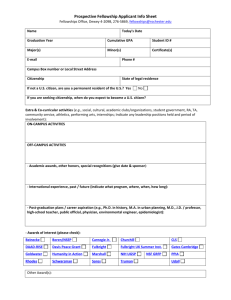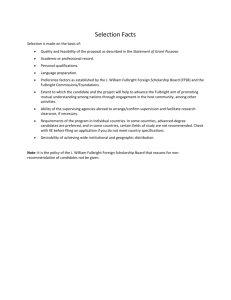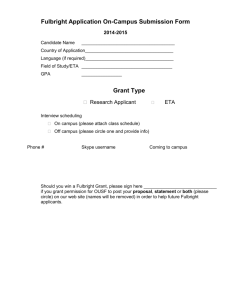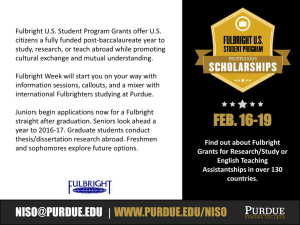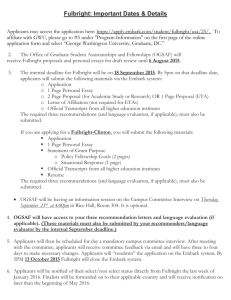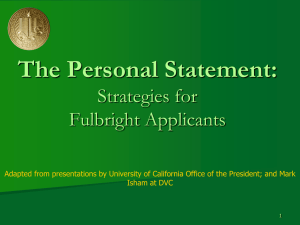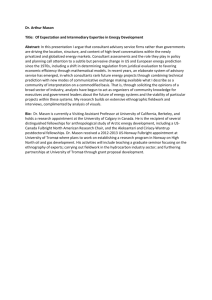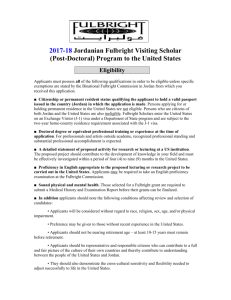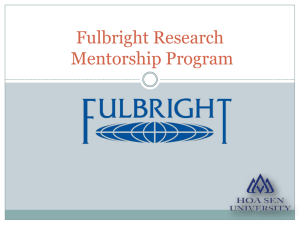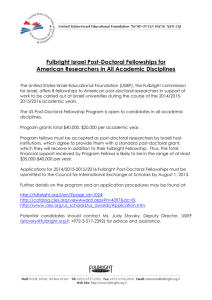Getting started on your Fulbright Application
advertisement
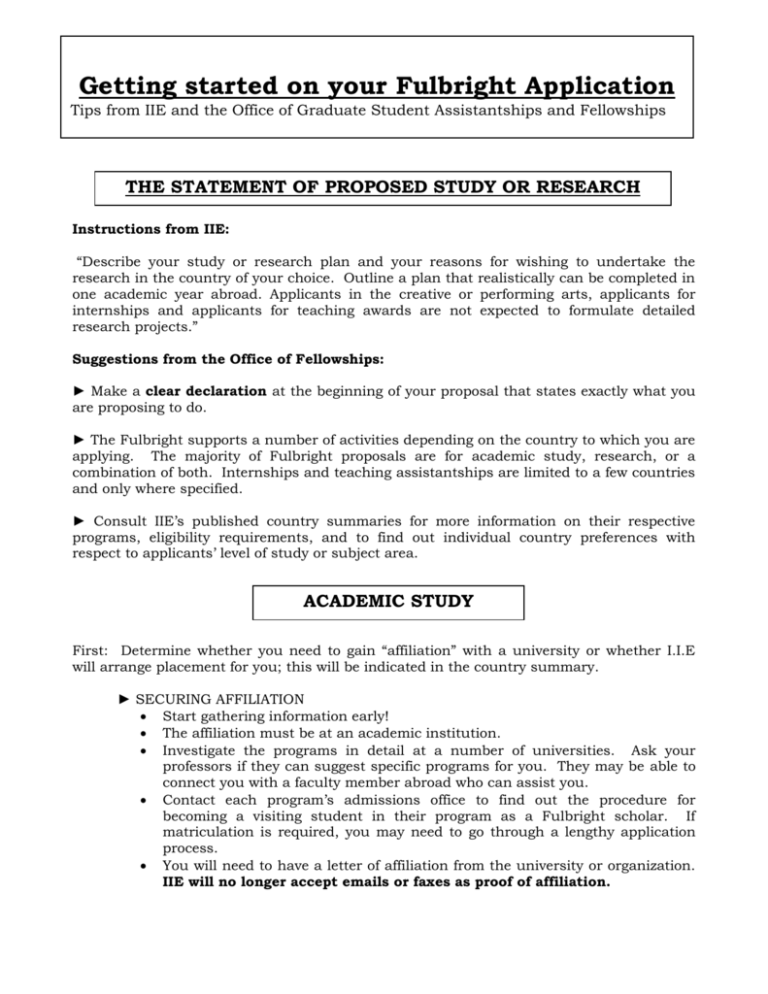
Getting started on your Fulbright Application Tips from IIE and the Office of Graduate Student Assistantships and Fellowships THE STATEMENT OF PROPOSED STUDY OR RESEARCH Instructions from IIE: “Describe your study or research plan and your reasons for wishing to undertake the research in the country of your choice. Outline a plan that realistically can be completed in one academic year abroad. Applicants in the creative or performing arts, applicants for internships and applicants for teaching awards are not expected to formulate detailed research projects.” Suggestions from the Office of Fellowships: ► Make a clear declaration at the beginning of your proposal that states exactly what you are proposing to do. ► The Fulbright supports a number of activities depending on the country to which you are applying. The majority of Fulbright proposals are for academic study, research, or a combination of both. Internships and teaching assistantships are limited to a few countries and only where specified. ► Consult IIE’s published country summaries for more information on their respective programs, eligibility requirements, and to find out individual country preferences with respect to applicants’ level of study or subject area. ACADEMIC STUDY First: Determine whether you need to gain “affiliation” with a university or whether I.I.E will arrange placement for you; this will be indicated in the country summary. ► SECURING AFFILIATION Start gathering information early! The affiliation must be at an academic institution. Investigate the programs in detail at a number of universities. Ask your professors if they can suggest specific programs for you. They may be able to connect you with a faculty member abroad who can assist you. Contact each program’s admissions office to find out the procedure for becoming a visiting student in their program as a Fulbright scholar. If matriculation is required, you may need to go through a lengthy application process. You will need to have a letter of affiliation from the university or organization. IIE will no longer accept emails or faxes as proof of affiliation. ► FOR COUNTRIES WHERE AFFILIATION IS NOT REQUIRED This information is useful for all Fulbright applicants, not just those who are pursuing Academic Study If the country will place you at a university, you still must describe an academic program of interest. Fulbright might consider your suggestions and place you at your first choice university. You might, however, be placed at another university so it is best to describe courses or programs found at more than one university in the country. Determine from a number of programs in the country what coursework you would like to undertake. Be able to describe what you hope to learn from these types of courses. In addition, how will this academic program help you to the next step in your career? Will you go on to another degree here in the US? Will it inform your career? ACADEMIC STUDY WITH A RESEARCH PROJECT ► Decide in advance what will be the proportion of academics and research in the plan of your proposal. Will a few courses inform your research, or will the research project be a side project to an academic program? ► Your level of study-- Master’s program, Master’s candidate, or doctoral candidate -- might indicate an appropriate mix. Be sure to connect your research to the academic study. The policies at the university you are interested in might be another factor. If doing academic study, make sure your proposal’s main focus is on this component. Side research projects should be mentioned but not presented as the centerpiece of your proposal. If research is the main focus for your proposal, you must include a detailed methodology for your project. (see below) Refer to the suggestions above for the academic component. RESEARCH PROJECT – Doctoral and Master’s Candidates ► Before you begin, brainstorm ideas by writing them down. You want an idea that is feasible and persuasive. Consult with professors, professional colleagues and the Office of Fellowships as you tailor your proposal. ► All research projects must be clearly described and show evidence of a specific methodology. ► Write clearly and cleanly. Start with the 5 Ws and H—who, what, when where, why and how. Avoid technical or discipline-specific jargon. ► Address the following areas: Research Topic Research Question(s): Specifically, what is your plan for trying to answer your research question(s)? Access Requirements (and Your Plan for Gaining Access) ♦ Subjects (Will interviews be part of your project? Who will they be and how will you gain access to them?) ♦ Archives ( Which ones? What types of documents will you be looking for? Will you need access to special libraries or archives?) Feasibility ♦ Is the scope of the research narrow enough to be completed in approximately 9 months? ♦ How will the culture and politics of the host country impact your work? ♦ How do the resources of the host country support your project? ♦ Is your language facility adequate to carry out your project? If not, how will you accomplish your research? Validity ♦ What purpose does the research serve? ♦ What will happen to the data? ♦ What is the end product? (thesis, dissertation data collection, paper, etc.) ♦ What is your background in this subject area? Extra tips for Doctoral Candidates Important: Doctoral students should have had their dissertation proposal approved by the time of application for the Fulbright. If the proposal has not been approved, be able to indicate when it is likely to be approved. This date must be before the month the applicant expects to depart on a Fulbright fellowship. Doctoral students applying for the Fulbright to conduct dissertation research should consult primarily with their dissertation committee on their Fulbright proposals. The Office of Fellowships will also comment on the draft. TEACHING ASSISTANTSHIPS AND INTERNSHIPS ► Teaching assistantships, internships and special opportunities in business are available in a limited number of countries. ► In some cases, these countries supply additional instructions on information you should include in your application with respect to the programs. If you are applying for a teaching assistantship, you are not expected to present an extensive research plan. Your proposal should address the following areas ♦Why you want to undertake a teaching assistantship? ♦What are your qualifications? ♦How do you expect to benefit from the assignment and how will you make use of your experience upon your return? ♦What will you do in the host country outside of the classroom? THE PERSONAL STATEMENT Instructions from IIE: The Fulbright Personal Statement is not a resume or curriculum vitae in the traditional sense. Your personal statement should be a narrative, an intellectual biography than a reiteration of work history, etc. Describe professional commitments and on-campus or community activities, to which a serious commitment, or from which leadership potential is clearly demonstrated. This enables the committee members to get a feel for the candidate as a person and thus permits them to form a judgment regarding such items as seriousness of purpose, adaptability, etc. This statement should be a narrative giving a picture of yourself as an individual. It should deal with your personal history, family background, influences on your intellectual development, the educational and cultural opportunities (or lack of them) to which you have been exposed, and the ways in which these experiences have affected you. Also include your special interests and abilities, career plans, and life goals, etc. It should not be a recording of facts already listed on the application or an elaboration of your statement of proposed study. There is no set “form” for a Fulbright personal statement, so be creative and include whatever makes you and your intellectual history unique. If you have a period of poor academic performance, you may want to include an explanation of it in your essay. This could well help the committee overcome any doubts raised by subpar grades or a series of withdrawals on your transcript. Suggestions from the Office of Fellowships: ►The personal statement is your opportunity to put yourself down on paper. This essay should support your proposal by describing your “intellectual self” without reiterating the material in your proposal. While this essay should explain your academic interests, it should not be purely academic in nature. A committee member, who in most cases will not have the opportunity to interview you, will want to see your personal side as it relates to who you are academically. ►There is no set formula for a “winning essay” but we have some general “don’ts” which might help steer you away from some common pitfalls. The Office of Fellowships has file copies of some GW Fulbright Fellows’ winning essays and proposals. You may not make copies of them but you are welcome to read them for inspiration. We recommend that you DON’T: ♦GO TOO FAR BACK INTO YOUR PAST. – Evaluators are more interested in who you are now. If there was an extremely significant event that led you to where you are today, think carefully about how you present it and move quickly to the present and your current interests and motivations. ♦REPEAT MATERIAL FROM YOUR PROPOSAL. – Keep in mind that the committee will read both essays. If you repeat material from your proposal, you are wasting precious space that should be used to tell them something about yourself you haven’t told them already. The two should relate, not echo one another. ♦LIST FROM YOUR RESUME OR TRANSCRIPT. – Again, the personal statement is a place for you to describe who you are. Listing adds nothing to your essay that a committee member would not learn elsewhere in your application. If you mention something from your resume and transcript, be sure that the experience or course was significant and reflect on how it has affected you rather than just telling about it.
